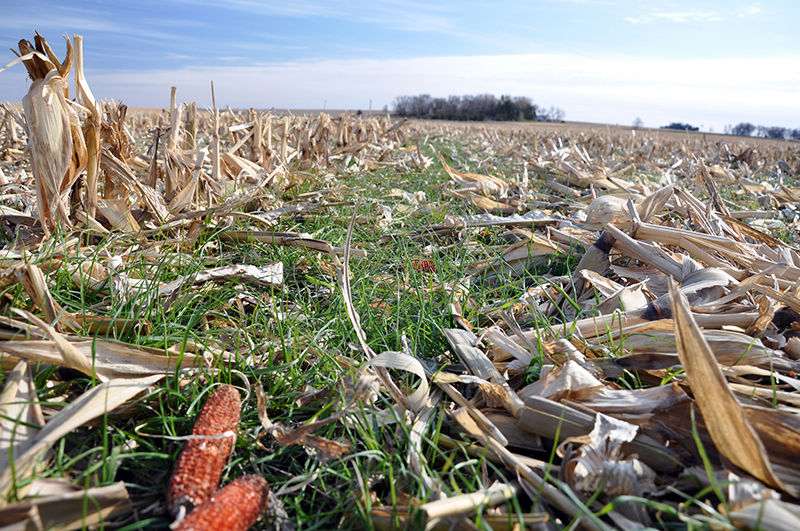Infrastructure package could include cover crop incentives, but concerns remain

If you looked closely at my farm earlier this fall, you could see the hillsides starting to green up. Sprouts of rye were emerging through the corn stover that was left in the field after harvest, offering a winter blanket of protection for the soil and nutrients.
It was an investment in seed, equipment and labor but planting cover crops is something that both my young renter and I agree will be a good practice over the long-run, along with moving to no-till. He purchased a drill and was able to get this year’s cover crop planted and growing before the frost.
But last year, things didn’t go so well. He planted a slightly different mix, including some turnip seed, by flying it on the field after harvest. Unfortunately, it didn’t rain for three weeks after the seed was planted and the much anticipated first cover crop was barely to be seen.
From discussions with farmers around the country—especially those who are just starting to explore cover crops—it’s clear that we still have a lot to learn about cover crops, including where they work, where they don’t work and how they work. In some arid parts of the United States, growers are increasingly concerned that cover crops just won’t work at all and that new federal incentives could cause unintended consequences.
However, some state and federal lawmakers are very focused on incentivizing more farmers and landowners to plant cover crops.
A provision of congressional Democrats’ Build Back Better Act that would pay producers $25 per acre to plant cover crops is getting serious attention from sectors in the agriculture industry with ambitious climate goals, though others are unsure of how effective the measure will be in comparison to existing programs.
The provision would provide payments for up to 1,000 acres per producer. Non-operating landowners could get payments of $5 per acre to encourage them to let farmers grow cover crops on rented acreage.
Adam Smith, an Iowa farmer who plants cover crops and also works for Beck’s seed company, said $25 is a good start. The money could cover the price of some low-cost seeds, but producers might still have to pay for more expensive varieties.
“I think it would definitely cover your seed costs, depending on what mix you’re putting on there,” he said. “If you’re doing just a straight rye or oats or something, those are the cheaper ones. You start getting into the radishes and turnips and blends, those get a little bit higher.”
Current U.S. Department of Agriculture programs, like the Environmental Quality Incentives Program and the Conservation Stewardship Program, can already help cover the cost of cover crops. The BBB provision was written in a way to give the USDA flexibility to determine how best to carry out the program, including what types of crops qualify as cover crops, a congressional source told Agri-Pulse.
According to a 2021 USDA Economic Research Service report, median per-acre payments through USDA’s EQIP program can range from $29 to $62 depending on the state and which cover crops are planted, while median per-acre payments for the CSP range from $7.96 to $14.65. However, EQIP is meant to encourage trial adoption of cover crops for up to five years, and producers are only eligible on fields where they have not planted cover crops, in addition to not being able to harvest their cover crop for grain or seed.
CSP is geared more toward improving existing practices, and farmers enrolled in the program sign a five-year contract to engage in conservation activities that may include diversifying their cover crop mixes.
Compared to some high-paying state programs, the proposed federal payments may not seem like much, which may impact the number of participants.
According to a 2019-2020 survey conducted by Sustainable Agriculture Research and Education, which compiles information on conservation practices like cover crops, 47.6% of the producers surveyed paid between $11 and $20 per acre for seeds. Just over 15% paid only $6 to $10 per acre, 15.9% paid $21 to $25, and 9.6% paid $26 to $30. On the higher end of the spectrum, 17.8% said they paid $31 or more for seed.
Some experts are a little more skeptical on how far the BBB program could go in incentivizing more producers to use cover crops. Naveen Adusumilli, an associate professor of agricultural economics and agribusiness at Louisiana State University, said it’s still too early to tell if this program will be effective because it’s unclear how USDA will implement it.
Adusumilli said he believes it may be more effective to use the money to establish insurance premium rebate programs that reduce insurance premiums for cash crops based on the number of cover crop acres a farmer plants. The Biden administration has created the temporary Pandemic Cover Crop Program that is giving producers a $5-per-acre rebate per acre of cover crops on their crop insurance premiums. Iowa, Indiana and Illinois offer something similar at the state level.
“There are several programs that this $25 per acre and/or this additional $5 per acre payment could supplement those existing programs,” Adusumilli said. “There’s not just one way here, we have about two or three ways to get creative in encouraging farmers to put that practice on the ground.”
Editor’s note: Sara Wyant can be reached at www.agri-pulse.com. Associate Editor Noah Wicks contributed to this column.



